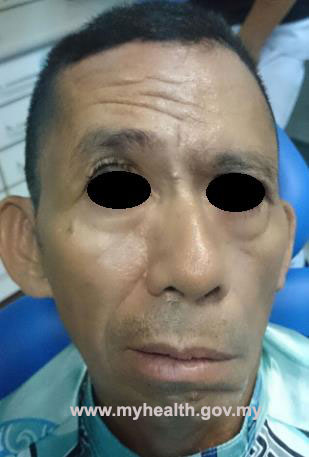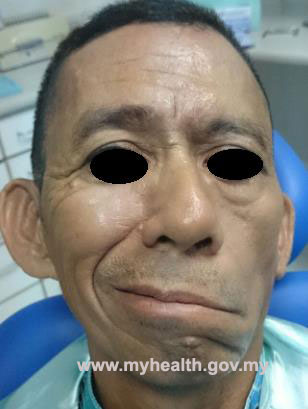Introduction
Facial paralysis or weakness is as the partial or total loss of voluntary facial movement because of facial nerve damage. This condition occurs due to temporary or permanent damage to the facial nerve. It usually occurs on just one side of the face, but can involve both sided of the face, or just the lower portion of the face (Fig 1). Facial paralysis or weakness can be very disfiguring as the ability to smile is impaired ( Fig.2). In any event, this causes a major cosmetic problem and is very distressing for the patient. If the paralysis persists, surgery may be required to improve facial expression.
There are many conditions, diseases or disorder that leads to facial paralysis. Facial paralysis can be
- Congenital (birth defect)
-
Uncommon
-
Can involve one side of the face (unilateral facial paralysis) or both sides of the face (bilateral facial paralysis).
-
Unilateral paralysis is usually associated with hemifacial microsomia.
-
Bilateral cases often result from Moebius (or Möbius) syndrome which is an extremely rare congenital neurological disorder that primarily affects the muscles that control facial expression and eye movement.
-
- Acquired (occur at any time in life).
- Happen when injury to the brain or facial nerves during or after birth.
- The condition can be temporary or persistent depending on the causes
Cause
Damage to the facial nerve in the area of the brain mainly affects the lower part of the face. The common causes of this type of facial paralysis include:
- Cerebrovascular accident (stroke).
- Head trauma.
- Brain Tumour.
- Infection.
In damage to the facial nerve in the area of the face, there is weakness of the muscles of facial expression and eye closure on the affected side of the face. Bell’s palsy is the most common form of this kind of paralysis of the face (75%)[3]. The cause is unknown and may relate to viral infection of the facial nerve. Most of the patients with Bell’s palsy make a full recovery over the time. Other causes of LMN facial paralysis include:
- Diabetes.
- Middle-ear disease/ infection.
- Lesion of skull base.
- Birth trauma.
- Parotid lesion.
- Trauma to branches of the facial nerve.
- Inferior dental regional anaesthetic affecting the facial nerve.
Signs and Symptoms
Clinical signs and symptoms of facial paralysis vary with the location, severity, and chronicity of the lesion. Smiling, speech and ability to whistle are commonly affected. The facial muscles droop or become weak. During smiling, the face sags and is drawn across to the opposite side. In addition, on the affected side, facial paralysis can cause:
- Facial asymmetry ( Fig. 1).
- Inability to express emotion.
- Difficulty talking.
- Difficulty eating or drinking.
- Difficulty keeping liquids in the mouth.
- Difficulty closing the eye with drying or tearing of the eye (Fig.3).
- Muscle twitching.
Facial paralysis may occur with other symptoms including:
- Facial pain
- Headaches or seizures
- Earaches, ringing in one or both ears, and sensitivity to sound ,hearing loss
- Impaired or altered sense of taste
- Weakness of the entire left or right side of the body

Fig 1: Facial asymmetry at rest .The left side of the face droop with inability to raise the eyebrow.

Fig 2 : Patient attempting a smile.The left facial paralysis become more noticeable.

Fig 3: Unable to close the eyelid tightly.
Complication
Facial paralysis can have a major impact on a person’s quality of life. If it left untreated or persist for long term, serious complications may arise which may include any of the following:
- Persistent facial weakness – Facial weakness can cause facial disfigurement which can have far-reaching psychosocial consequences. Psychological problems include stress, anxiety, depression and low self-esteem. Please kindly seek help or discuss with your clinician if you experience any of the above symptoms.
- Eye problems – The eyelid is too weak to close completely and staying open for long period of times. The lack of protective tear film can result in excessive eye drying, infection and corneal ulceration or even worse, being blindness. The complications can be prevented by the use of eye drops, eye ointments and eye patches. In some cases, surgery is needed to restore eyesight or improve the eye closure.
- Synkinesis – There is involuntary contraction of facial muscles responsible for movement, smiling and blinking. When intentionally trying to move one part of face, another part automatically moves. This happen as a result of nerve fiber begins to regrow in the wrong direction. It may be discomfort and interfere with the daily activities.
- Reduced sense of taste – This happen as a result of the damage nerve do not heal properly
Treatment
Management of the patient with facial paralysis is a multidisciplinary endeavour. Treatment of facial paralysis may be medically or surgically depending on the cause.
Bell’s palsy (mostly obtain a full recovery)
- Anti-inflammatory medication- A short course of oral steroid (e.g. prednisolone) to reduce the inflammation surrounds the nerve.
- Antiviral medication may help if it is viral related infection.
- Massage- Facial massage may help to strengthen the facial muscle and prevent permanent damage.
- If do not recover fully, cosmetic surgery may be recommended to improve eye closure and facial appearance.
Other Facial Paralysis
Surgery may be recommended to repair or replace the damaged nerves or muscle, or to remove tumour. A variety of cosmetic procedures are available to improve facial symmetry and function. These procedures include:
- Placement of small gold weight in the upper eyelid to help the eye close more properly.
- Botulinum toxic injection – to reduce involuntary facial movement and to restore some facial expression and contour.
- Lower eyelid shortening procedures to prevent eye dryness and improve eye closure.
Eye Care
Eye protection is primary concern to prevent ulceration of the cornea of the eye.
- Keep the eye moist by using artificial tears throughout the day and apply a lubricant at night.
- Wear glasses if at outside to prevent particles of dust lodge into the eye
- Taping the eyelid with tape to ensure the eye is firmly closed to prevent it from dryness
- Seek treatment immediately if encounter eye pain, redness or visual loss despite lubrication.
Alternative Names
Paralysis of the face, facial palsy
References
- House JW, Brackman DE; House Brackman Facial Nerve Grading System 2010.
- http://www.healthline.com/health/facial-paralysis#Overview1
- Scully, Crispian. (2013). 13 –Sensory and motor changes and taste abnormalities. In C. Scully (Ed.), Oral and Maxillofacial Medicine (Second Edition) (pp. 119-130): Churchill Livingstone.
| Last Reviewed | : | 12 May 2015 |
| Writer | : | Dr. Ch’ng Lay Ling |
| Accreditor | : | Dr. Ferdinand Jesudian Kovilapillai |








